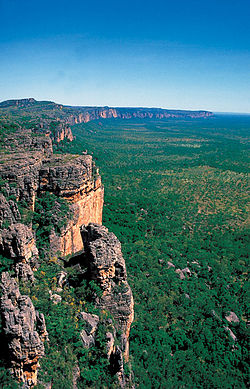Kakadu Tourism
Attractions
There are many different reasons as to why so many people each year travel to Kakadu:
World Heritage Area
Dramatic Landscape
Kakadu has a very unique and dramatic landscape with stunning flood plains, gorges, billabongs, woodlands, rock plateaux, rock escarpments and plummeting waterfalls.
Aboriginal Significance
The Kakadu area is extremely significant to the Aboriginal community. Their past is wrapped up in Kakadu. Many Aboriginal people have a strong social and historical connection with this area.
Kakadu contains thousands of years of history, culture and religion. Archaeological records suggest that the region of Kakadu has been inhabited by humans for 40,000 and 60,000 years.
Before the arrival of non-indigenous people to
Diverse and abundant
Aboriginal art
Kakadu contains one of the world’s largest collections of rock art with 5000 sites recorded and a further 10 000 sites are thought to exist. The paintings are estimated to range in age from 20 000 years to the present showing Aboriginal occupation for at least 20 000 to possibly 60 000 years.
Ubirr and Nourlangie Rock are two major public sites featuring rock art.
The rock art in Kakadu was painted to pass on knowledge of hunting, religion, stories, sorcery and magic.
Rock Art at Ubirr Rock
Number of visitors
Value to local community and economy
Tourism to the local community and economy is very beneficial. Tourism provides employment and income for the people of Kakadu. It is a good industry for the future generations, as it is sustainable.
Aside from mining tourism is the main income generating industry in Kakadu. The iconic Yellow River brings in millions of dollars from boat tours each year. Tourism is a great way to pass on the aboriginal culture to others.
On the 31st July 2008 the Federal Environment Minister Peter Garrett and the indigenous owners of Kakadu announced a campaign to change the way tourism is promoted and handled according to indigenous lore.

Concerns
Tourism potentially dangerous to the fragile environment of Kakadu if it is not managed and sustained properly. Threats to the environment include pollution, fire, destruction of Aboriginal art, habitat or ecosystem disruption and an increase in bacteria and fungi in water used for swimming, boating and aquaculture.
The Aboriginal community is currently working on effective and sustainable tourism.
The biggest concern in Kakadu today is the threat to the environment from mining.
The NT Government has pushed the idea of developing mining as a part of an economic strategy after the discovery of vast deposits of uranium were found in 1969-70.
The Jabiluka Mine
The Jabiluka mine is believed to contain an estimated 163,000 metric tons of uranium worth approximately A$10 billion. It is the largest undeveloped uranium deposit in the world. It is located in the heart of the Jabiluka area which contains the Boywek-Almudj site which is sacred to the Mirrar community.
Fortunately on the 25th of February 2005 the Jabiluka long-term care and maintenance agreement was signed. This means that the Energy Resources of Australia Ltd (ERA) cannot do any future mining development of uranium deposits at Jabiluka without consent from the Mirrar community.
The Ranger Mine
The Ranger mine was opened in 1980. The NT government allowed it to be opened, even after there were government and Aboriginal enquires that recommended against the plan.
The negative impacts to the environment and a series of hazardous accidents outweigh the benefits of the few jobs at the Ranger Mine.
16 million tons of radioactive tailings have piled up and continually leach into the area’s water supply.
There are sacred sites around the Ranger Mine that could be destroyed.
The ERA plans to close the Ranger Mine in 2010.
Kakadu National Park
Kakadu National Park is a beautiful environment that we have to protect and care for so that it can be seen by the future generations to come.
Liv Norris


